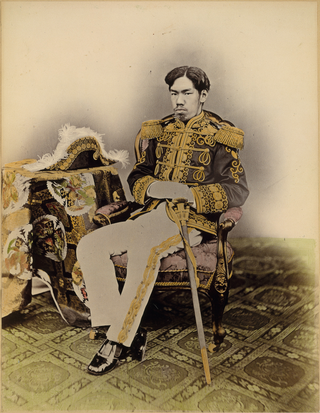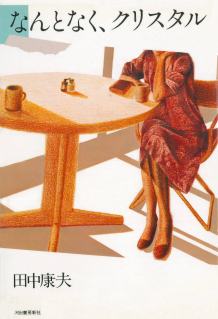
Bruce Cumings is an American historian of East Asia, professor, lecturer and author. He is the Gustavus F. and Ann M. Swift Distinguished Service Professor in History, and the former chair of the history department at the University of Chicago. He specializes in modern Korean history and contemporary international relations.
Kokugaku was an academic movement, a school of Japanese philology and philosophy originating during the Tokugawa period. Kokugaku scholars worked to refocus Japanese scholarship away from the then-dominant study of Chinese, Confucian, and Buddhist texts in favor of research into the early Japanese classics.
Japanese philosophy has historically been a fusion of both indigenous Shinto and continental religions, such as Buddhism, Taoism and Confucianism. Formerly heavily influenced by both Chinese philosophy and Indian philosophy, as with Mitogaku and Zen, much modern Japanese philosophy is now also influenced by Western philosophy.

The Japanese term shinbutsu bunri (神仏分離) indicates the separation of Shinto from Buddhism, introduced after the Meiji Restoration which separated Shinto kami from buddhas, and also Buddhist temples from Shinto shrines, which were originally amalgamated. It is a yojijukugo phrase.

Yōichi Komori is a critic of Japanese modern literature and a social activist in Japan. He is currently a professor at the University of Tokyo, Japan.

Hirata Atsutane was a Japanese scholar, conventionally ranked as one of the Four Great Men of Kokugaku (nativist) studies, and one of the most significant theologians of the Shintō religion. His literary name was Ibukinoya (気吹舎), and his primary assumed name was Daigaku. He also used the names Daikaku (大角), Gentaku (玄琢), and Genzui (玄瑞). His personal name was Hanbē (半兵衛).
Masao Maruyama was a leading Japanese political scientist and political theorist. His expertise lay in the history of Japanese political thought, to which he made major contributions.

Arif Dirlik was a Turkish-American historian who published on historiography and political ideology in modern China, as well as issues in modernity, globalization, and post-colonial criticism. Dirlik received a BSc in Electrical Engineering at Robert College, Istanbul in 1964 and a PhD in History at the University of Rochester in 1973.
John Whitney Hall was an American historian of Japan who specialized in premodern Japanese history. His life work was recognized by the Japanese government, which awarded him the Order of the Sacred Treasure.
Kokoku Hihyo was a leading Japanese monthly trade magazine focusing on advertisement, especially TV commercials. It was published between 1979 and 2009.
Marilyn Ivy is an associate professor of anthropology at Columbia University. She received a Ph.D. in anthropology from Cornell University, an M.A. in history from the University of Hawaiʻi, and a B.A. in Asian studies from the University of Oklahoma. Prior to teaching at Columbia, Ivy taught at the University of Chicago and the University of Washington.

Andō Nobumasa was a late-Edo period Japanese samurai, and the 5th daimyō of Iwakitaira Domain in the Tōhoku region of Japan, and the 10th hereditary chieftain of the Andō clan. He was the eldest son of Andō Nobuyori and his mother was a daughter of Matsudaira Nobuakira of Yoshida Domain. His childhood names were Kinnoshin and Kinnosuke and he was known most of his life as Andō Nobuyuki, taking the name of Nobumasa only after he became a rōjū.

Yasunosuke Gonda was a Japanese sociologist and film theorist who played an important role in the study of popular entertainment and helped pioneer statistical studies of everyday life in Japan.

The Meiji Restoration, referred to at the time as the Honorable Restoration, and also known as the Meiji Renovation, Revolution, Regeneration, Reform, or Renewal, was a political event that restored practical imperial rule to Japan in 1868 under Emperor Meiji. Although there were ruling emperors before the Meiji Restoration, the events restored practical abilities and consolidated the political system under the Emperor of Japan. The goals of the restored government were expressed by the new emperor in the Charter Oath.

Anti-Chinese sentiment has been present in Japan since at least the Tokugawa period.
Non-simultaneity or nonsynchronism is a concept in the writings of Ernst Bloch which denotes the time lag, or uneven temporal development, produced in the social sphere by the processes of capitalist modernization and/or the incomplete nature of those processes. The term, especially in the phrase "the simultaneity of the non-simultaneous", has been used subsequently in predominantly Marxist theories of modernity, world-systems, postmodernity and globalization.
Masao Miyoshi was a scholar of literature and culture and Hajime Mori Endowed Chair in Japanese Language and Literature at the University of California, San Diego.
Farewell My Concubine is a 1985 novel by Lilian Lee. The novel contains scenes not present in the film adaptation and scenes which had been altered in the film version. In 1993 Lee published a revised version of Farewell My Concubine, after the release of the film.
Jason Ānanda Josephson Storm is an American academic, philosopher, social scientist, and author. He is currently Professor and Chair in the Department of Religion and Chair in Science and Technology Studies at Williams College. He also holds affiliated positions in Asian studies and Comparative Literature at Williams College. Storm's research focuses on Japanese religions, European intellectual history from 1600 to the present, and theory in religious studies. His more recent work has discussed disenchantment and philosophy of social science.

Somehow, Crystal is a Japanese novel by Yasuo Tanaka. Published in magazine form as the winner of the 17th Bungei Prize in 1980, it was also nominated for the Akutagawa Prize, and published in book form by Kawade Shobō Shinsha in 1981. A bestseller shortly after publication, the novel was controversial among contemporary critics for its apparent glorification of luxury consumption and its use of extensive annotations to identify desirable real-world products, brands, services, and locations encountered by the book's fictional characters. Academic critics have since identified Somehow, Crystal as an early and important example of Japanese postmodern literature. The book has been translated into Korean, German, and English, and a Japanese film adaptation was released by Shochiku in 1981.










